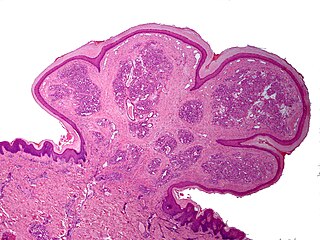Related Research Articles

Granuloma inguinale is a bacterial disease caused by Klebsiella granulomatis characterized by genital ulcers. It is endemic in many less-developed regions. It is also known as donovanosis, granuloma genitoinguinale, granuloma inguinale tropicum, granuloma venereum, granuloma venereum genitoinguinale, lupoid form of groin ulceration, serpiginous ulceration of the groin, ulcerating granuloma of the pudendum, and ulcerating sclerosing granuloma. Oral manifestations are also notably seen. The lesions of oral cavity are usually secondary to active genital lesions.

A granuloma is an aggregation of macrophages that forms in response to chronic inflammation. This occurs when the immune system attempts to isolate foreign substances which it is unable to eliminate. Such substances include infectious organisms including bacteria and fungi, as well as other materials such as foreign objects, keratin and suture fragments.

Necrobiosis lipoidica is a necrotising skin condition that usually occurs in patients with diabetes mellitus but can also be associated with rheumatoid arthritis. In the former case it may be called necrobiosis lipoidica diabeticorum (NLD). NLD occurs in approximately 0.3% of the diabetic population, with the majority of sufferers being women.

Pyogenic granuloma or pyogenic fibroma is a vascular tumor that occurs on both mucosa and skin, and appears as an overgrowth of tissue due to irritation, physical trauma, or hormonal factors. It is often found to involve the gums, the skin and nasal septum, and has also been found far from the head such as in the thigh.

Granuloma annulare is a fairly rare, chronic skin condition which presents as reddish bumps on the skin arranged in a circle or ring. It can initially occur at any age and is four times more common in females.

Erythema annulare centrifugum (EAC), is a descriptive term for a class of skin lesion presenting redness (erythema) in a ring form (anulare) that spreads from a center (centrifugum). It was first described by Darier in 1916. Many different terms have been used to classify these types of lesions and it is still controversial on what exactly defines EAC. Some of the types include annular erythema, erythema perstans, erythema gyratum perstans, erythema gyratum repens, darier erythema and erythema figuratum perstans.

Eosinophilic granuloma is a form of Langerhans cell histiocytosis. It is a condition of both human and veterinary pathology.
Aquarium granuloma is a skin condition caused by Mycobacterium marinum, characterized by a skin lesion that presents roughly three weeks after exposure.
Mercury granulomas is the result of mercury exposure, a skin condition characterized by foreign-body giant cell reaction.

Zirconium granulomas are a skin condition characterized by a papular eruption involving the axillae, and are sometimes considered an allergic reaction to deodorant containing zirconium lactate. They are the result of a delayed granulomatous hypersensitivity reaction, and can also occur from exposure to aluminum zirconium complexes. Commonly, zirconium containing products are used to relieve toxicodendron irritation. The lesions are similar to those from sarcoidosis, and commonly manifest four to six weeks after contact. They appear as erythematous, firm, raised, shiny papules. Corticosteroids are used to ease the inflammation, but curative treatment is currently unavailable.
Silica granulomas are a skin condition which may be caused by automobile and other types of accidents which produces tattooing of dirt into the skin that then induces the granuloma formation.

Majocchi's granuloma is a skin condition characterized by deep, pustular plaques, and is a form of tinea corporis. It is a localized form of fungal folliculitis. Lesions often have a pink and scaly central component with pustules or folliculocentric papules at the periphery. The name comes from Professor Domenico Majocchi, who discovered the disorder in 1883. Majocchi was a professor of dermatology at the University of Parma and later the University of Bologna. The most common dermatophyte is called Trichophyton rubrum.
Localized granuloma annulare is a skin condition of unknown cause, tending to affect children and young to middle-aged adults, usually appearing on the lateral or dorsal surfaces of the fingers or hands, elbows, dorsal feet, and ankles.

Generalized granuloma annulare is a skin condition of unknown cause, tending to affect women in the fifth and sixth decades, presenting as a diffuse but symmetrical, papular or annular eruption of more than ten skin lesions, and often hundreds.
Subcutaneous granuloma annulare is a skin condition of unknown cause, most commonly affecting children, with girls affected twice as commonly as boys, characterized by skin lesions most often on the lower legs.
Perforating granuloma annulare is a skin condition of unknown cause, usually appearing on the dorsal hands, presenting as papules with a central keratotic core.
Granuloma annulare in HIV disease is a skin condition characterized typically by papular and generalized skin lesions.
Annular elastolytic giant-cell granuloma is a cutaneous condition characterized histologically by a dermal infiltrate of macrophages.
Actinic granuloma is a cutaneous condition characterized histologically by a dermal infiltrate of macrophages.
Granuloma multiforme is a cutaneous condition most commonly seen in central Africa, and rarely elsewhere, characterized by skin lesions that are on the upper trunk and arms in sun-exposed areas. It may be confused with tuberculoid leprosy, with which it has clinical similarities. The condition was first noted by Gosset in the 1940s, but it was not until 1964 that Leiker coined the term to describe "a disease resembling leprosy" in his study in Nigeria.
References
- ↑ James, William D.; Berger, Timothy G.; et al. (2006). Andrews' Diseases of the Skin: clinical Dermatology. Saunders Elsevier. ISBN 978-0-7216-2921-6.
| This cutaneous condition article is a stub. You can help Wikipedia by expanding it. |